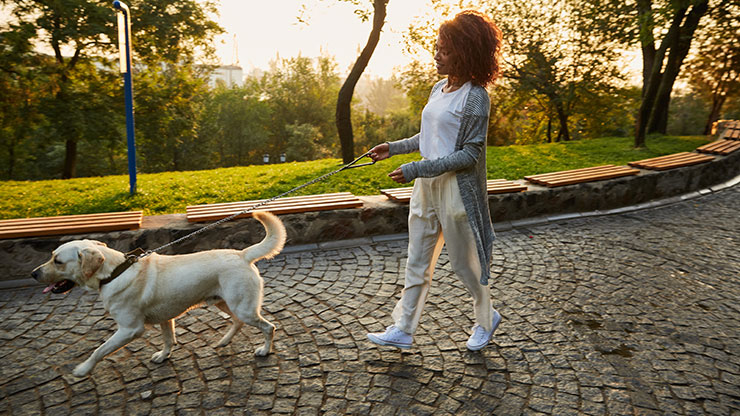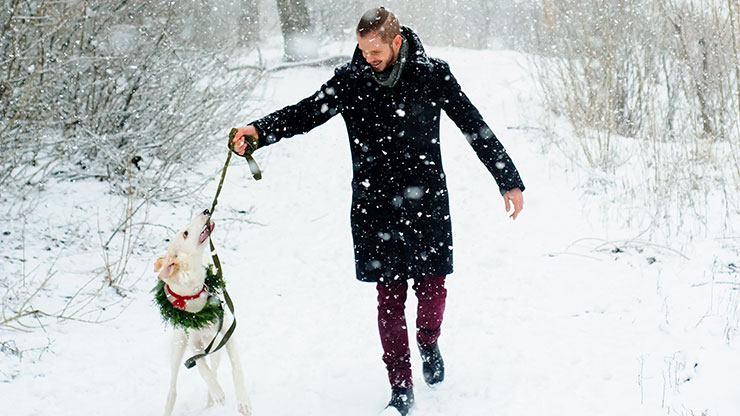
8 Ways to Get the Most Out of Walk Your Dog Month 2023
January is Walk Your Dog month, and it’s the perfect excuse to kick-start your new year fitness goals while spending time with your four-legged friend. In this article, we’ll explore eight ways to get the most out of the month, from boosting your mental well-being to supporting your furry friend's health.
So, keep reading as we talk about all things dog-walking and spending time with your best friend...
What is Walk Your Dog Month?
Walk Your Dog Month is an international event that takes place each January. It has a simple purpose to encourage dog owners everywhere to spring back into action in the New Year and boost their and their pet’s health. Here are our eight top tips to help you get the most out of the month:
1. Reach your fitness goals
For many of us, the new year marks the start of several new goals, and one of the most common resolutions is to get fit and kick-start physical health. It can be difficult to get back into a routine after a long festive break, especially in the cold and wet winter weather, so committing to taking your dogs on daily walks is a great place to start.
To increase your chances of success, start small. Work your way up to longer walks and be consistent. Dogs love routine, and in turn, it will motivate you to get out at the same time each day to go for a walk.
Walking is an excellent form of cardiovascular exercise and can help to improve strength and overall fitness.
2. Beat the winter blues
With long, gloomy days and being stuck inside due to miserable weather, the winter blues can impact you in many ways. The official term for more severe cases of the winter blues is Seasonal Affective Disorder (SAD), which is thought to affect thousands of people each year. Although they are mammals, there is no evidence that winter blues affect dogs. However, they can be influenced by your mood and may be turned off walks due to poor weather as well.
There are plenty of ways to beat these sad feelings, from making time for self-care to taking vitamin D supplements. Even spending time with your dog at home is said to help with depression. However, exercise is thought to be a great way to help reduce and manage the symptoms of SAD as it helps your body to make feel-good chemicals. Plus, daily exposure to sunlight can help boost your stores of vitamin D.
So, not only can the fresh air and endorphins help to improve your mood, but walking can also help manage disorders like SAD or depression on an ongoing basis and, therefore, help your dog feel happier.

3. Boost your dog's health
Walking your dog regularly is essential for its physical health. Dog obesity is on the rise, and whether the cause is overeating or lack of exercise, walking your dog can be a great way to keep it from getting worse.
Much like the benefits of walking for humans, regular exercise can help protect your dog’s cardiovascular system, support their joints and muscles, boost their metabolism and burn that extra energy.
If your dog has gained weight and you’re not sure why, if they struggle to walk very far, or if you have any other health concerns, you should visit your veterinarian before starting a new exercise schedule.
4. Make training fun
Walking is a great way to make training fun and incentivize good behavior for your dog. Several training areas are perfect for practicing during walks, such as learning to sit before crossing the street and walking well on a leash.
Leash skills are essential for all dogs to learn as it makes the walk more enjoyable for both parties and teaches your dog how to behave around other animals or walk to heel on command.
If you train your dog while walking, start by taking a few healthy dog treats to incentivize certain behaviors before they become a habit. Stay consistent, be patient, and don’t tell your dog if they get it wrong - instead, use positive reinforcement and lead the way by being calm.
5. Boost mental stimulation
While poor behavior can often be a signal that your dog needs more training, it can also indicate they just aren’t getting enough exercise to burn the energy they have. Examples of poor behaviors include:
- Snarling or showing gums
- Biting or chewing
- Destroying objects or toys
- Constant barking
- Whining or seeking attention
- Dominant behavior
The earlier you can detect bad behavior in your dog and take steps to correct it, the better. Regular walks, no matter the weather, are key to keeping them mentally stimulated.
6. Boost your dog's social skills
Correctly socializing your dog is important for numerous reasons and helps teach them to interact with the world around them safely and healthily without fear. Fearful dogs can react in unpredictable ways, such as showing signs of dominance or displaying behaviors that can lead to difficult situations with other dogs.
If your dog is nervous around others, start walking around the outer edge of a field or dog park away from other dogs. Slowly work your way up and allow your dog to sniff and approach other dogs - on a leash, of course.

7. Stay safe while walking
Walking safely is highly important no matter where you live - in built-up areas, roads will be busier and more dangerous, while in rural, dimly lit areas in the winter, visibility can be poor. That is why you should ensure that:
- Both you and your dog are highly visible - if in doubt, wear a reflective jacket and consider a reflective coat or collar for your dog.
- Stay in well-lit areas, and bear in mind personal security.
- Take water with you to ensure you and your pet stay hydrated.
- Grit, salt, and de-icer on roads can cause burns on paw pads during the winter, so consider protecting your dog's feet.
While it’s important to get out and about during the winter months, it’s not worth risking your dog’s health - so always play it safe and be careful.
8. Donate to a shelter
Now is the perfect time to donate to your local dog adoption center or rescue home. The winter is a difficult time of year for shelters, as they need more resources for things like dog bedding or hefty heating bills.
Dog shelters also have to raise funds for medical treatments, and they often have an influx of new pets at this time of year due to dogs being unwanted Christmas gifts. If you can’t afford to donate, why not help out by volunteering?
Now you know how to get the most out of Walk Your Dog month this January. Where will your adventures take you?










